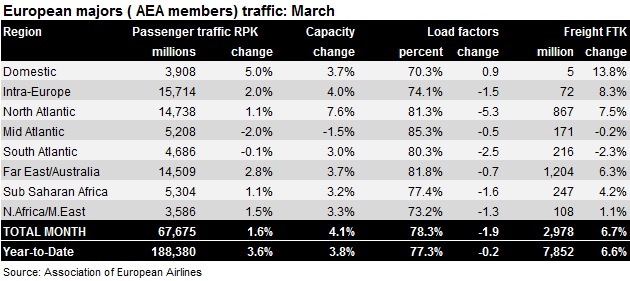May underlined some strong financial performances from Europe’s budget carriers as they came out of the traditionally loss-making winter months in strong positions.
EasyJet trimmed its loss to £53 million ($89 million) over its traditionally weak winter first half ending March 2014. "EasyJet has delivered a solid first half performance despite the less benign capacity environment," says airline chief executive Carolyn McCall. "The results reflect our on-going progress against our strategic priorities, and demonstrate the structural advantage EasyJet has against both legacy and low cost competition in the European short haul market."
While budget carrier giant Ryanair's net profit of €523 million ($716 million) for the 12 months ended March 2014 was down 8% on the previous year, it was slightly higher than the carrier had guided after earlier profit warnings and still enough to rank it as the second most profitable low-cost carrier in the world last year. It is also forecasting a strong return in profit this year off the back of a bright first half, issuing full-year earnings guidance in the €580-€620 million range. If achieved, this would be a record profit for the airline.
IAG chief financial officer Enrique Dupuy meanwhile praised rapidly expanding Vueling's first quarter performance in keeping its losses pretty much unchanged even during its growth phase.
Central European carrier Wizz Air meanwhile revealed a profitable position after disclosing full financial details for the first time in support of plans to float on the London stock exchange.
Wizz Air is to offer new shares to raise proceeds of €200 million ($273 million), and will also offer shares of current investors – including those of main stockholder Indigo Partners.
The airline has been operating for 10 years and, over its last fiscal year, achieved revenues of just over €1 billion and EBITDAR earnings of €241 million, as well as a net profit of €89 million. Wizz says it has achieved a compound annual growth rate in earnings of 21% for the past five years, and 22% in revenues.
EUROPEAN AIRLINE NEWS: MAY SNAPSHOT
Scandinavia’s SAS Group cut its full-year forecast as market overcapacity and yield pressure continue to affect the company’s finances;
Austrian Airlines’ flight and cabin crews rejected management’s proposed new wage agreement that would reverse a controversial decision two years ago to transfer all operations to regional arm Tyrolean Airways;
Restructuring German carrier Air Berlin implemented its €550 million ($766 million) recapitalisation after raising €252 million in new bonds alongside the €300 million convertible perpetual bond placed by shareholder Etihad Airways;
After formally completing its acquisition of Irish carrier CityJet, new owners Intro Aviation will make a decision on the renewal of its BAE SystemsAvro RJ85 regional jet fleet this year as it plans to retire the type by the end of 2016;
EUROPEAN AIRLINE TRAFFIC: APRIL
European airline load factor jumped two points in April as the later falling of the busy Easter period this year boosted traffic figures in comparison with the same month last year.
Figures from nearly 20 European carriers for last month show passenger load factor up 2.2 percentage points in April, to 81.2%. The improved load factors reflect a near 7% rise in passenger traffic on capacity lifted only 4%.
The traffic figures have been bolstered by Easter falling in April this year compared with March last year. By comparison, passenger traffic rose less than 2% in March and load factor dropped 2.1 percentage points.

While passenger traffic was strongly improved for almost all carriers, Lufthansa’s performance in April was hit by the fallout from a three-day walkout by pilots which forced it to cancel nearly 4,000 flights at the start of the month. The strike resulted in a 3% cut in the German carrier’s capacity during April as it flew 7% fewer flights than in the same month in 2013. Consequently passenger traffic fell 2% at the mainline carrier. However, Lufthansa’s load factor still improved a point to 78.1%.
AEA MEMBER TRAFFIC BY MARKET: MARCH
Growth of Association of European Airlines (AEA) member traffic in March stalled as the later timing of Easter this year distorted direct comparison with the same month in 2013. Passenger traffic increased only 1.6% on 4% more capacity, contributing to a new two point fall in passenger load factor to 78.3%. Over the first three months of the year passenger load factor is running fractionally down among AEA carriers, though the April figures will be boosted by the inclusion of the busy Easter traffic period

EUROPEAN AIRLINE FLEET SUMMARY: APRIL
The active European airline fleet in April was just under 6,000 aircraft, while there were 612 aircraft parked.

Source: Cirium Dashboard
















